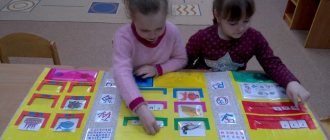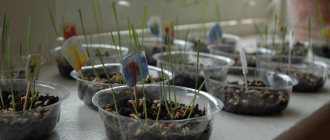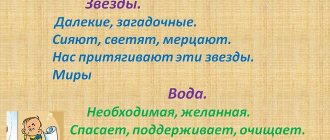How to prepare notes for a lesson at a preschool educational institution.
4. Tasks.
It is methodically incorrect to write: “ goals
OOD".
The goal
is the final and
overall
result, extended over time.
What goal can be achieved, for example, in 15 minutes of educational activity in a younger group? It is more correct to write the word “goal”, for example, when developing the planning of a complex
(i.e., several educational activities), when developing
a project
(since it is multifaceted) and other
complexes of educational activities
. Moreover,
there is only one goal , and there may be several tasks.
For
a specific lesson (OOD),
specific
are suitable that must be
solved by the end
of this educational activity (after 15 minutes in the junior group or after 30 minutes in the preparatory group).
That is, if a teacher wrote a problem in the OOD notes, then he must solve it in the OOD process
. Therefore, you don’t need to write 10-15 problems in your notes. Five, maximum six. Tasks can be divided:
— into 3 groups: developmental, educational, educational
(educating),
— into 2 groups: educational, developmental.
Many teachers write the word “educational” instead of the word “educational”, meaning only educational tasks.
But the concept of “education”
(Law “On Education in the Russian Federation”)
includes the process of training and education
.
This means that the group of educational tasks must include both teaching and educational tasks. In this case, there will be only two groups of tasks: developmental and educational
.
Training tasks
indicate what children will learn in class.
“teach”
in problems !
The verb “teach” is used if the teacher teaches the child any techniques (for example, teach jumping, or: teach to hold a pencil, or: teach drawing techniques, indicate which one)
!
It is more correct to write: “form ideas, skills”, “promote the formation of skills”, “create conditions”, “develop”, “involve”, etc. Educational
(educational)
tasks
indicate what mental, aesthetic, moral and ethical qualities will be formed in the lesson.
Developmental tasks
indicate what will be reinforced and clarified in the lesson, the development of which mental functions of children will be involved.
Can the word “tasks”
"replace with the phrase "
software content
".
5. Further indicate:
— methods and techniques;
- vocabulary work;
— material and equipment;
—
you can indicate:
preliminary work;
- you can indicate: planned (or expected) results.
6. Progress of organized educational activities.
Introductory part
(motivational stage). The teacher must motivate children to engage in cognitive (or play) activities using a problem (or play) situation. This situation is described in the outline.
Other abstracts on the topic “Pedagogy”:
- Main aspects of social work with orphans in the Russian Federation and in the Trans-Baikal Territory
- Methodology for creating interschool groups as one of the forms of organizing specialized education
- Using computer technology in studying the initial course of mathematical analysis
- Formation of cognitive activity of students through research activities
- Integrated biology and chemistry lesson on the topic “Structural organization of a living cell”
Abstract to the music director's work program
The main idea of the work program is humanization, the priority of educating universal human values: goodness, beauty, truth, self-worth of preschool childhood. Musical education in preschool educational institutions is carried out on the basis of the main educational program of a preschool educational institution.
The work program meets the requirements of the Federal State Educational Standard and the age characteristics of children. The program includes the following sections:
- “Listening”;
- “Singing”;
— “Musical and rhythmic movements”;
— “Playing children's musical instruments.”
The work program is based on a polyartistic approach based on the integration of different types of musical activities:
- performance;
- rhythm;
— musical and theatrical activities, which contributes to the preservation
integrity of perception, allows you to optimize and enhance the child’s musical development.
The purpose of the work program: to create conditions for the development of musical and creative abilities of preschool children through music, rhythmic plasticity, and theatrical activities.
Tasks of the work program:
— formation of the foundations of musical culture of preschool children;
— formation of value orientations by means of musical art; — ensuring the emotional and psychological well-being, protection and promotion of children’s health.
Abstract to the work program of a teacher-psychologist
This work program has been developed on the basis of the main educational program of a preschool educational institution in accordance with the Federal State Educational Standard for Education for working with preschool children.
The work program determines the content and structure of the activities of a teacher-psychologist in the following areas: psychoprophylaxis, psychodiagnostics, psychocorrection, psychological counseling, psychological education and support for the activities of preschool educational institutions in working with children from 4 to 7 years old, parents of pupils, teachers, specialized specialists, and the administration of preschool educational institutions.
The work program includes the organization of psychological support for the activities of preschool educational institutions in the main educational areas - social-communicative, cognitive, speech, artistic, aesthetic and physical development, as a result, the unity of educational, developmental and training goals and objectives of the educational process in preschool educational institutions is ensured, which ensures the diversified development of children, taking into account their age and individual characteristics.
Taking into account the specifics of the professional activity of a preschool educational psychologist, significant attention is paid to targeted activities for the prevention, maintenance and correction of developmental disorders in children.
The content of the work program is implemented taking into account the age and individual characteristics of preschoolers.
The goal of the program is to determine the main directions of psychological support for the implementation of educational initiatives to ensure the full formation of integrative qualities of preschool children, including general culture, the development of physical, intellectual and personal qualities with the priority direction of cognitive and speech development; prerequisites for educational activities that ensure social success, preservation and strengthening of the health of preschool children, correction of deficiencies in their mental development.
This goal is specified in the following tasks:
— prevent the occurrence of child development problems;
— provide assistance (assistance) to the child in solving current developmental problems.
— increase the psychological and pedagogical competence (psychological culture) of parents of pupils and teachers;
— provide psychological support for the implementation of the educational program and the development of preschool educational institutions as a whole.
The content of psychological and pedagogical work includes:
1 Educational activities carried out in the process of organizing various types of children's activities: play, communication, work, cognitive-research, productive (visual, constructive, etc.), music, reading.
2 Educational activities carried out during restricted periods.
3 Independent activities of children.
3 Interaction with children’s families on the implementation of the basic general education program of preschool education
Psychological support for the implementation of the main general education program of preschool educational institutions for the development of educational fields
The content of the activities of a teacher-psychologist within the framework of the psychological-medical-pedagogical commission of a preschool educational institution:
-work with children;
-work with teachers;
-working with parents.
Form of control - monitoring frequency 2 times a year: October (initial), April (final).
Abstract to the work program of a physical education instructor The work program is developed on the basis of the main educational program of a preschool educational institution for working with preschool children.
The content of the work program is implemented taking into account the age, individual, and gender characteristics of preschoolers. The work program determines the content and structure of activities in sections: - “Formation of initial ideas about a healthy lifestyle”; - "Physical Culture". The purpose of the work program: preservation, strengthening, protection of children's health, introducing preschoolers to a healthy lifestyle. Objectives of the work program: - preservation, strengthening, protection of children's health; increasing mental and physical performance, preventing fatigue; — formation in children of initial ideas about a healthy lifestyle; — ensuring harmonious physical development, improving skills in basic types of movements; — development of initiative, independence and creativity in motor activity, the ability to self-control, self-esteem when performing movements; - development of interest in participation in outdoor and sports games and physical exercises, activity in independent motor activity; interest and love for sports; - education of beauty, grace, expressiveness of movements, formation of correct posture; — formation in preschoolers of the need for daily physical activity. The system for assessing the results of mastering the program is presented in the form of targets.
Abstract to the main educational program of the preschool educational institution
Aizhan Aliyeva
Abstract to the main educational program of the preschool educational institution
The main general education program of the municipal budgetary preschool educational institution Combined kindergarten ”
Engels municipal district of the Saratov region is compiled for the 2020-2020 academic year and contains
the main sections and a brief presentation: “Target section”
,
“Content section”
and
“Organizational section”
.
The target section consists of 4 subsections: Explanatory note (goals and objectives, principles and approaches to program , regulatory documents, program structure and explanations , features of the program ); Age and individual characteristics of the contingent of children in preschool institutions; Planned results of mastering the educational program; Features of the organization of pedagogical diagnostics and monitoring. It states that the Program was developed in accordance with regulatory documents, such as the Constitution of the Russian Federation, the Convention on the Rights of the Child, Federal Law No. 273 - Federal Law “On Education in the Russian Federation”
etc. The goals and objectives
of the Program .
The main goal of the educational process in preschool educational institutions is to create conditions for the development of cognitive and communicative activity in students, creative self-realization and initiative with the help of modern developmental technologies.
In the process of forming this Program and constructing educational activities, principles were taken into account, based on cultural-historical and systemic-activity approaches to child development, which are the methodology of the Federal State Educational Standard for Education.
The Program describes characteristics and characteristics of child development that are of the program from 2 - 3 years; from 3 - 4 years; from 4 - 5 years; from 5 - 6 years; from 6 - 7 years. Target guidelines for preschool education at the initial and final stages are set, and intermediate results of educational activities for children in various age groups are presented. The relevance of using pedagogical diagnostics in a preschool institution is described and the principles and stages of conducting pedagogical diagnostics are given.
Section I also describes the monitoring of the educational process in preschool institutions, its purpose and schedule. Monitoring assumes:
1. constant collection of information about objects of control, i.e. performing a tracking function;
2. studying the object according to the same criteria in order to identify the dynamics of changes;
3. compactness, minimalism of measuring procedures and their inclusion in the pedagogical process.
The content section consists of 4 subsections: Mandatory part. The content of educational activities for children to master educational areas ; The part formed by the participants in educational relations ; Interaction of preschool educational institutions with society; Features of interaction between the teaching staff and the families of students.
The content section represents the general content of the preschool educational program, in order to ensure the full development of the child’s personality and is carried out in accordance with the areas of development presented in five educational areas : “Physical development”
.
“Socio-communicative development”
,
“Cognitive development”
,
“Speech development”
,
“Artistic and aesthetic development”
.
For each area of development, goals and principles are set, and the content of educational activities for each age group of children is described quite fully.
The second subsection states that the direction “Cognitive development”
and
“Speech development”
is for preschool
priority and is reflected in innovation activities.
In the process of educational activities, modern developmental technologies are used, which make it possible to most fully implement the priority direction for the development of intellectual and creative thinking in the process of cognitive and speech development.
In the third subsection, great importance is attached to the creation of a mutually beneficial social partnership for the development of an institution in the mode of an open educational space , ensuring the full implementation of the interests of the individual, society, and the state in the education of the younger generation. programs and agreements for interaction with other educational institutions is indicated .
The fourth subsection talks about the importance of interaction between the teaching staff and the families of students.
Functions of interaction between the teaching staff and the families of students:
-familiarization of parents with the content and methodology of educational activities ;
-psychological and pedagogical education;
-involvement of families of pupils in joint activities with children and teachers;
-providing qualified assistance to families experiencing any difficulties;
-interaction between teachers and public authorities of preschool educational institutions
— parent committee of the group, Council of Parents of Preschool Educational Institutions.
One of the important conditions for the implementation technology of preschool education is the joint upbringing and development of preschool children with parents, the involvement of parents in the educational process of a preschool institution.
The organizational section consists of 10 independent subsections: Logistics and technical support of educational institutions of educational institutions; Daily routine for warm and cold periods of the year; Schedule; Syllabus; Schedule of direct educational activities ; Schedule of joint educational activities and cultural practices in special moments; Schedule of children’s independent activities during restricted periods; Organization of motor mode in a preschool institution; Model for organizing the educational process of a preschool institution for the academic year; Features of the organization of a developing subject-spatial environment.
The basis for the development of the main educational program of preschool education is the Federal State Educational Standard for Preschool Education , approved by Order of the Ministry of Education and Science of the Russian Federation No. 1155 of November 17, 2013 Software and methodological support for the educational process .
The daily routine in a preschool institution is drawn up in accordance with the Resolution of the Chief State Sanitary Doctor of the Russian Federation dated May 15, 2013 No. 26 Moscow dated “On approval of SanPiN 2.4.1.3049-13 “Sanitary and epidemiological requirements for the design, content and organization of the work regimen preschool educational organizations " (Registered with the Ministry of Justice of Russia on May 29, 2013 No. 28564)
The sequence and duration of regime processes during the day are presented in two versions for each age
(in the warm and cold periods of the year)
. When drawing up the daily routine, we took into account the children’s need for a rational motor mode and the need for alternating active activity and rest.
Municipal budgetary preschool educational institution – “Kindergarten No. 17”
operates with a five-day work week (excluding Saturday and Sunday, working hours from 07.00 to 19.00 hours.
Curriculum of MBDOU "Kindergarten No. 17"
is a normative document that determines the maximum volume
of educational load for pupils, types of continuous educational activities and establishes a list of educational areas , and the amount of time allocated for carrying out continuous educational activities . The curriculum presents the distribution of the amount of continuous educational activities with students, which makes it possible for MBDOU “Kindergarten No. 17”
to use a modular approach, to build a curriculum on the principles of differentiation and variability when mastering
program content by age groups.
The basis for organizing the educational process in a preschool institution is the principle of comprehensive thematic planning, which is developed taking into account the principle of seasonality, social and personally significant events for participants in the educational process , as well as based on the interests and needs of children. The topics of the events are focused on the age and all areas of development of a preschool child, and also take into account the personal interest of children in the phenomena of the child’s moral life.
The main general education program of the municipal budgetary preschool educational institution Combined kindergarten ”
Engels municipal district of the Saratov region is compiled for the 2020-2020 academic year and contains
the main sections and a brief presentation: “Target section”
,
“Content section”
and
“Organizational section”
.
The target section consists of 4 subsections: Explanatory note (goals and objectives, principles and approaches to program , regulatory documents, program structure and explanations , features of the program ); Age and individual characteristics of the contingent of children in preschool institutions; Planned results of mastering the educational program; Features of the organization of pedagogical diagnostics and monitoring. It states that the Program was developed in accordance with regulatory documents, such as the Constitution of the Russian Federation, the Convention on the Rights of the Child, Federal Law No. 273 - Federal Law “On Education in the Russian Federation”
etc. The goals and objectives
of the Program .
The main goal of the educational process in preschool educational institutions is to create conditions for the development of cognitive and communicative activity in students, creative self-realization and initiative with the help of modern developmental technologies.
In the process of forming this Program and constructing educational activities, principles were taken into account, based on cultural-historical and systemic-activity approaches to child development, which are the methodology of the Federal State Educational Standard for Education.
The Program describes characteristics and characteristics of child development that are of the program from 2 - 3 years; from 3 - 4 years; from 4 - 5 years; from 5 - 6 years; from 6 - 7 years. Target guidelines for preschool education at the initial and final stages are set, and intermediate results of educational activities for children in various age groups are presented. The relevance of using pedagogical diagnostics in a preschool institution is described and the principles and stages of conducting pedagogical diagnostics are given.
Section I also describes the monitoring of the educational process in preschool institutions, its purpose and schedule. Monitoring assumes:
1. constant collection of information about objects of control, i.e. performing a tracking function;
2. studying the object according to the same criteria in order to identify the dynamics of changes;
3. compactness, minimalism of measuring procedures and their inclusion in the pedagogical process.
The content section consists of 4 subsections: Mandatory part. The content of educational activities for children to master educational areas ; The part formed by the participants in educational relations ; Interaction of preschool educational institutions with society; Features of interaction between the teaching staff and the families of students.
The content section represents the general content of the preschool educational program, in order to ensure the full development of the child’s personality and is carried out in accordance with the areas of development presented in five educational areas : “Physical development”
.
“Socio-communicative development”
,
“Cognitive development”
,
“Speech development”
,
“Artistic and aesthetic development”
.
For each area of development, goals and principles are set, and the content of educational activities for each age group of children is described quite fully.
The second subsection states that the direction “Cognitive development”
and
“Speech development”
is for preschool
priority and is reflected in innovation activities.
In the process of educational activities, modern developmental technologies are used, which make it possible to most fully implement the priority direction for the development of intellectual and creative thinking in the process of cognitive and speech development.
In the third subsection, great importance is attached to the creation of a mutually beneficial social partnership for the development of an institution in the mode of an open educational space , ensuring the full implementation of the interests of the individual, society, and the state in the education of the younger generation. programs and agreements for interaction with other educational institutions is indicated .
The fourth subsection talks about the importance of interaction between the teaching staff and the families of students.
Functions of interaction between the teaching staff and the families of students:
-familiarization of parents with the content and methodology of educational activities ;
-psychological and pedagogical education;
-involvement of families of pupils in joint activities with children and teachers;
-providing qualified assistance to families experiencing any difficulties;
-interaction between teachers and public authorities of preschool educational institutions
— parent committee of the group, Council of Parents of Preschool Educational Institutions.
One of the important conditions for the implementation technology of preschool education is the joint upbringing and development of preschool children with parents, the involvement of parents in the educational process of a preschool institution.
The organizational section consists of 10 independent subsections: Logistics and technical support of educational institutions of educational institutions; Daily routine for warm and cold periods of the year; Schedule; Syllabus; Schedule of direct educational activities ; Schedule of joint educational activities and cultural practices in special moments; Schedule of children’s independent activities during restricted periods; Organization of motor mode in a preschool institution; Model for organizing the educational process of a preschool institution for the academic year; Features of the organization of a developing subject-spatial environment.
The basis for the development of the main educational program of preschool education is the Federal State Educational Standard for Preschool Education , approved by Order of the Ministry of Education and Science of the Russian Federation No. 1155 of November 17, 2013 Software and methodological support for the educational process .
The daily routine in a preschool institution is drawn up in accordance with the Resolution of the Chief State Sanitary Doctor of the Russian Federation dated May 15, 2013 No. 26 Moscow dated “On approval of SanPiN 2.4.1.3049-13 “Sanitary and epidemiological requirements for the design, content and organization of the work regimen preschool educational organizations " (Registered with the Ministry of Justice of Russia on May 29, 2013 No. 28564)
The sequence and duration of regime processes during the day are presented in two versions for each age
(in the warm and cold periods of the year)
. When drawing up the daily routine, we took into account the children’s need for a rational motor mode and the need for alternating active activity and rest.
Municipal budgetary preschool educational institution – “Kindergarten No. 17”
operates with a five-day work week (excluding Saturday and Sunday, working hours from 07.00 to 19.00 hours.
Curriculum of MBDOU "Kindergarten No. 17"
is a normative document that determines the maximum volume
of educational load for pupils, types of continuous educational activities and establishes a list of educational areas , and the amount of time allocated for carrying out continuous educational activities . The curriculum presents the distribution of the amount of continuous educational activities with students, which makes it possible for MBDOU “Kindergarten No. 17”
to use a modular approach, to build a curriculum on the principles of differentiation and variability when mastering
program content by age groups.
The basis for organizing the educational process in a preschool institution is the principle of comprehensive thematic planning, which is developed taking into account the principle of seasonality, social and personally significant events for participants in the educational process , as well as based on the interests and needs of children. The topics of the events are focused on the age and all areas of development of a preschool child, and also take into account the personal interest of children in the phenomena of the child’s moral life.






